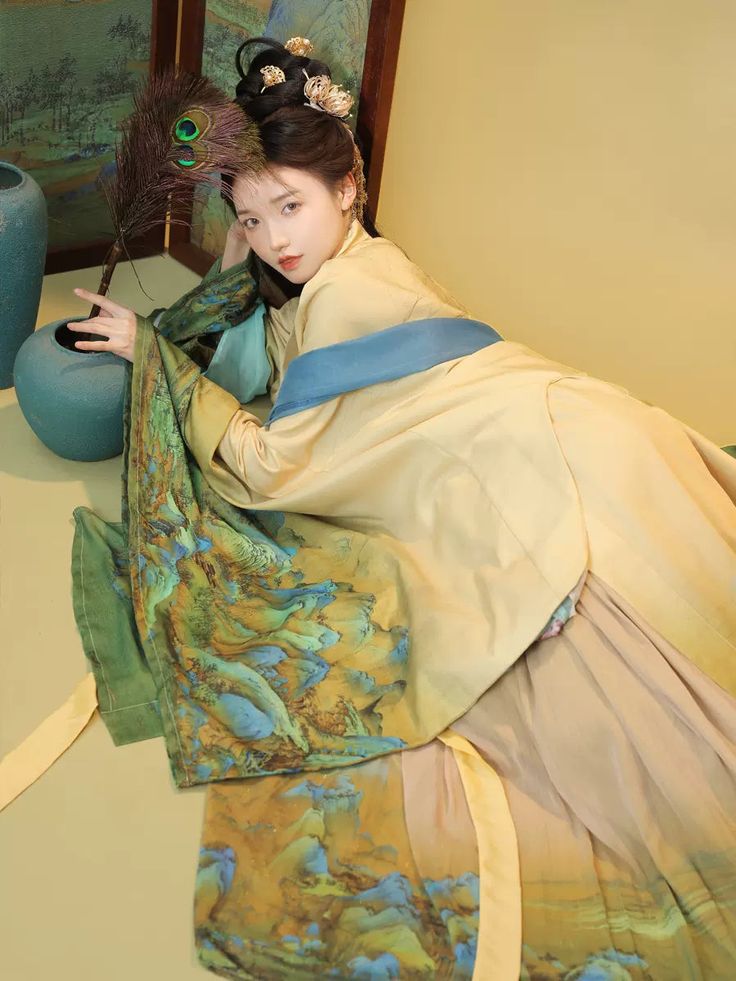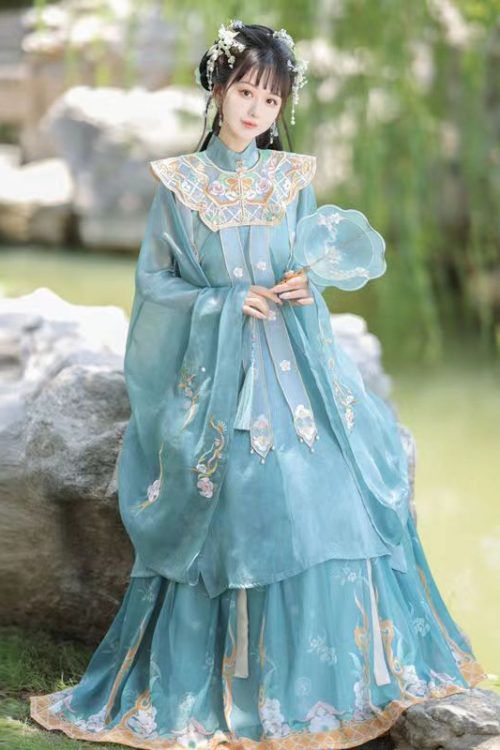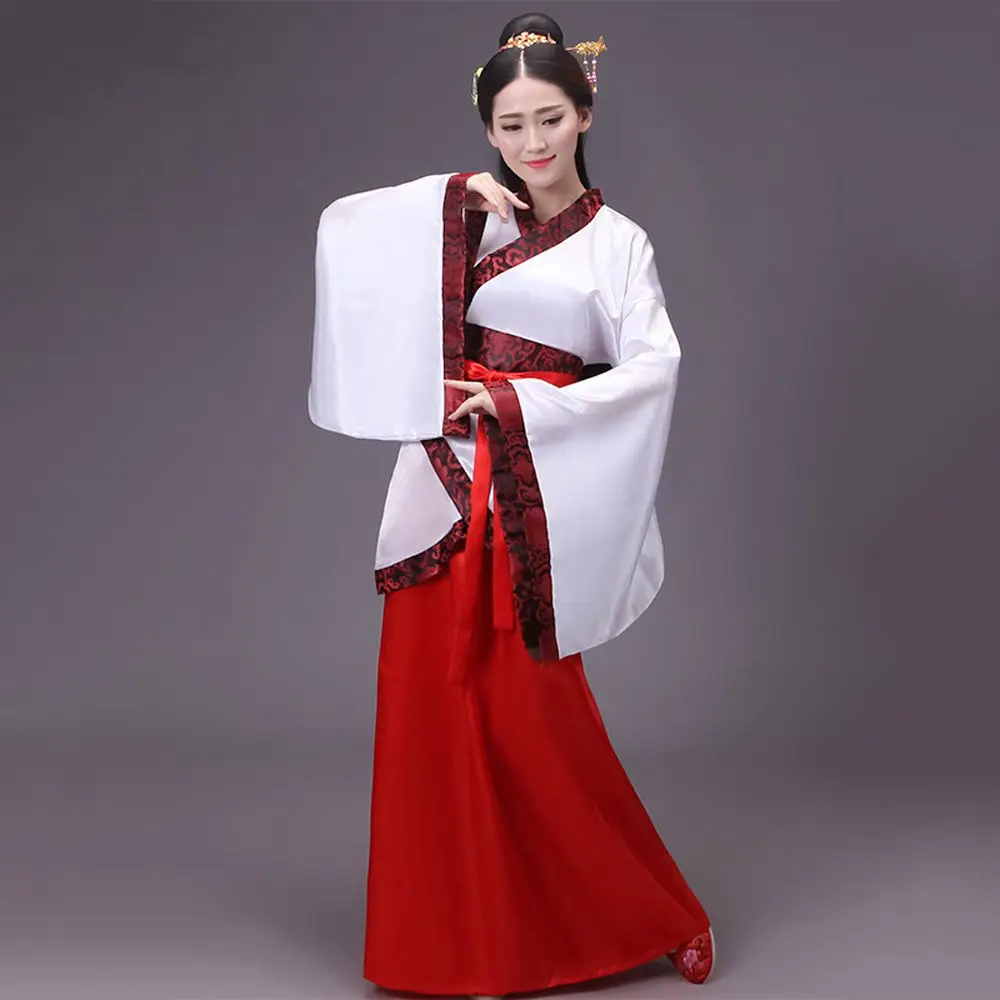The Influence of Nature on Hanfu Geometric Patterns
The intricate geometric patterns adorning Hanfu, the traditional clothing of the Han Chinese, have captivated observers for centuries. These patterns, far from being mere embellishments, hold profound significance, drawing inspiration from the natural world that has long shaped Chinese culture.

Early Origins
The earliest geometric patterns on Hanfu emerged during the Neolithic period, when humans began to observe and imitate the forms found in nature. The spirals and meanders that adorned pottery and textiles symbolized the cyclical nature of life and the movement of celestial bodies. As civilization progressed, these patterns evolved, incorporating elements from the surrounding environment.
Inspiration from Mountains and Rivers
Mountains, with their towering peaks and rugged slopes, became a prominent source of inspiration. The jagged lines and angular shapes of mountain ranges were translated into geometric patterns that conveyed strength and stability. Similarly, rivers and streams, with their meandering courses, inspired flowing patterns that represented fluidity and grace.

Flora and Fauna Influence
The flora and fauna of China also played a significant role in the development of Hanfu geometric patterns. The lotus flower, with its symmetrical petals and upright stem, became a symbol of purity and enlightenment. Its geometric representation adorned robes and accessories, conveying the wearer’s aspirations for spiritual growth. Animals, such as the phoenix and the dragon, were also depicted in geometric patterns, symbolizing power, wisdom, and good fortune.

Symbolic Meanings
The influence of nature on Hanfu geometric patterns extended beyond mere imitation. The patterns themselves were imbued with symbolic meanings that reflected the Chinese worldview. The square, for example, represented the earth, while the circle symbolized the heavens. The combination of these shapes in geometric patterns created a harmonious balance between the earthly and the celestial realms.
Color Significance
Moreover, the colors used in Hanfu geometric patterns were carefully chosen to evoke specific emotions and associations. Red, the color of fire and passion, was often used to convey joy and celebration. Blue, the color of water and the sky, represented tranquility and serenity. Green, the color of plants and growth, symbolized prosperity and abundance.
Conclusion
In conclusion, the geometric patterns on Hanfu are not simply decorative elements but rather a testament to the profound connection between Chinese culture and the natural world. Inspired by the mountains, rivers, flora, and fauna of their surroundings, these patterns embody the Chinese worldview and convey a rich tapestry of symbolic meanings. As such, they continue to captivate and inspire generations of Hanfu enthusiasts and scholars alike.
Cultural Symbolism in Hanfu Geometric Patterns
The intricate geometric patterns adorning Hanfu, the traditional clothing of the Han Chinese, hold profound cultural significance. Their origins can be traced back to ancient Chinese cosmology and the belief in the harmony between heaven, earth, and humanity.

Neolithic Beginnings
During the Neolithic period, geometric patterns emerged on pottery and textiles, representing the cyclical nature of life and the connection between humans and the cosmos. The square, for instance, symbolized the earth, while the circle represented heaven. These patterns were believed to possess protective and auspicious powers.
Development in the Shang Dynasty
As Chinese civilization developed, geometric patterns became more elaborate and symbolic. The Shang dynasty (1600-1046 BCE) introduced the concept of “eight trigrams,” a set of eight symbols representing the fundamental forces of nature. These trigrams were often combined to form more complex patterns, such as the “eight hexagrams” used in divination.
Zhou Dynasty Innovations
During the Zhou dynasty (1046-256 BCE), geometric patterns became increasingly stylized and incorporated into the design of ritual garments. The “cloud collar,” a distinctive feature of Hanfu, originated from the belief that clouds carried the blessings of heaven. The “dragon robe,” worn by emperors, was adorned with intricate geometric patterns representing the power and authority of the ruler.
Peak Sophistication in the Han Dynasty
In the Han dynasty (206 BCE-220 CE), geometric patterns reached their peak of sophistication. The “flying phoenix” pattern, symbolizing beauty and grace, became a popular motif on women’s clothing. The “swastika,” a symbol of good luck and prosperity, was also widely used.

Evolution Through History
Throughout Chinese history, geometric patterns on Hanfu have evolved to reflect the cultural, social, and political changes of the time. They have served as a means of expressing identity, status, and religious beliefs. Today, these patterns continue to be an integral part of Hanfu, preserving the rich cultural heritage of the Han Chinese people.
The Evolution of Hanfu Geometric Patterns Over Time
The intricate geometric patterns adorning Hanfu, the traditional clothing of the Han Chinese, have a rich and fascinating history. These patterns, known as “wen,” originated in ancient times and have evolved over centuries, reflecting the cultural and artistic influences of different eras.
Neolithic Patterns
The earliest geometric patterns on Hanfu emerged during the Neolithic period (c. 5000-2000 BCE). These patterns were simple and abstract, often consisting of lines, dots, and triangles. They were primarily used for decorative purposes and were often associated with religious or symbolic meanings.
Shang Dynasty Elaborations
During the Shang dynasty (c. 1600-1046 BCE), geometric patterns became more elaborate and sophisticated. The use of bronzeware and jade carving techniques allowed for the creation of intricate designs, such as spirals, meanders, and animal motifs. These patterns were often used to denote social status and were reserved for the ruling class.
Zhou Dynasty Refinements
The Zhou dynasty (c. 1046-256 BCE) saw a further refinement of geometric patterns on Hanfu. The introduction of silk weaving techniques enabled the creation of more complex and colorful designs. Patterns became more naturalistic, incorporating elements from nature, such as flowers, birds, and animals.
Peak Development in the Han Dynasty
During the Han dynasty (206 BCE-220 CE), geometric patterns reached their peak of development. The use of gold and silver thread in embroidery allowed for the creation of stunning and opulent designs. Patterns became more symmetrical and balanced, reflecting the influence of Confucianism and the emphasis on harmony and order.
Artistic Influences in Later Dynasties
The subsequent dynasties, including the Tang, Song, and Ming, continued to develop and refine geometric patterns on Hanfu. Each dynasty brought its own unique artistic influences, resulting in a wide variety of patterns. For example, the Tang dynasty was known for its bold and colorful patterns, while the Song dynasty favored more subtle and elegant designs.
Qing Dynasty Standardization
In the Qing dynasty (1644-1912), geometric patterns on Hanfu became more standardized and less elaborate. The influence of Western fashion led to the adoption of simpler and more geometric designs. However, traditional geometric patterns continued to be used in ceremonial and formal attire.
Contemporary Significance
Today, geometric patterns remain an integral part of Hanfu. They are used to create a wide range of designs, from simple and understated to elaborate and opulent. The revival of Hanfu in recent years has led to a renewed appreciation for these traditional patterns, which continue to inspire contemporary fashion and design.
